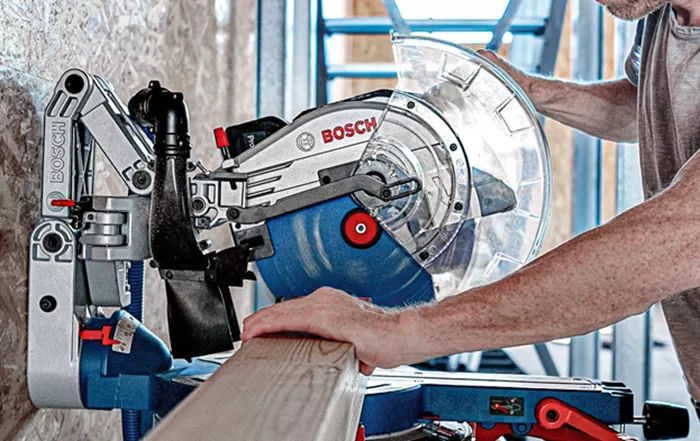A miter saw is an essential tool in woodworking and construction, designed for making precise crosscuts and angled cuts. Whether you’re working on intricate trim work, framing, or other detailed projects, a miter saw offers accuracy and efficiency. This guide provides an overview of miter saws, including their types, features, and usage tips to help you choose the right tool for your needs.
1. Types of Miter Saws
Basic Types
Standard Miter Saw: Also known as a chop saw, this type is used for making straight crosscuts and miter cuts at various angles. It’s ideal for tasks like cutting molding or trim.
Compound Miter Saw: This saw can make both miter and bevel cuts, allowing for more complex cuts. It’s useful for cutting crown molding or any work that requires angled cuts in two directions.
Sliding Compound Miter Saw: This advanced model combines the features of a compound miter saw with a sliding mechanism that allows the blade to move forward and backward. This feature increases the saw’s cutting capacity, making it suitable for larger boards.
Dual-Bevel Miter Saw: This saw can tilt in both directions, allowing for more versatility in bevel cuts. It’s particularly useful for working with intricate angles and complex projects.
2. Key Features to Consider
Blade Size and Type
Blade Diameter: Common blade sizes for miter saws include 8-inch, 10-inch, and 12-inch. Larger blades can cut through thicker materials, but the choice depends on your specific cutting needs.
Blade Type: Choose between carbide-tipped blades for durability and precision or other blade types based on the material you are cutting.
Cutting Capacity
Crosscut Capacity: The width of the material a miter saw can cut through depends on the size of the blade and the saw’s design. Sliding compound miter saws typically offer greater crosscut capacity.
Bevel Capacity: For angled cuts, consider the saw’s bevel range. Dual-bevel saws provide the most flexibility, allowing you to make compound cuts without flipping the material.
Accuracy and Precision
Laser Guides: Some miter saws come equipped with laser guides that project a line onto the material, helping ensure precise cuts.
Positive Stops: These are preset positions on the miter saw that make it easier to cut at common angles, such as 45 degrees or 90 degrees.
Dust Collection
Good dust collection systems help keep your workspace clean and improve visibility. Some miter saws feature built-in dust bags or ports that connect to a shop vac.
3. Safety Tips for Using a Miter Saw
Proper Setup
Secure the Material: Always secure the material you are cutting to prevent movement. Use clamps or a miter saw stand to stabilize the workpiece.
Check the Blade: Ensure the blade is sharp and properly installed. A dull or improperly installed blade can cause inaccuracies or accidents.
Personal Safety
Wear Safety Gear: Always wear safety glasses and hearing protection when operating a miter saw. The high-speed blade can produce flying debris and loud noise.
Keep Hands Clear: Maintain a safe distance from the blade. Use push sticks or other tools to guide the material if necessary.
4. Maintenance and Care
Routine Maintenance
Blade Replacement: Regularly check the condition of the blade and replace it when it becomes dull or damaged.
Cleaning: Keep the miter saw clean by removing sawdust and debris. Check and empty the dust bag or connect it to a dust extraction system.
Storage
Proper Storage: Store the miter saw in a dry, clean area to prevent rust and damage. If possible, cover it to protect it from dust and moisture.
5. Choosing the Right Miter Saw
Consider Your Needs
Project Type: For basic home projects, a standard or compound miter saw may suffice. For more complex tasks, consider a sliding compound or dual-bevel miter saw.
Budget: Miter saws vary in price based on their features and capabilities. Determine your budget and choose a saw that offers the best balance of features and value.
Brand and Warranty
Reputable Brands: Look for miter saws from well-known brands like DeWalt, Bosch, Makita, or Milwaukee, which are known for their quality and reliability.
Warranty: Check the warranty terms to ensure you are covered for any defects or issues that may arise with your miter saw.
6. Advanced Features and Upgrades
Digital Displays
Some modern miter saws feature digital displays that show precise angle settings, making it easier to achieve accurate cuts.
Extended Fence Systems
For larger projects, an extended fence system can provide additional support and stability for longer workpieces.
Laser and LED Lights
Enhanced visibility features like LED lights or advanced laser guides help improve cutting accuracy and ease of use.
Conclusion
A miter saw is a valuable tool for anyone involved in woodworking or construction. By understanding the different types of miter saws, key features, and safety practices, you can select the right saw for your needs and ensure efficient, accurate cutting. Whether you’re a professional tradesperson or a DIY enthusiast, investing in a high-quality miter saw will enhance the precision and quality of your projects.
Related Topics:

